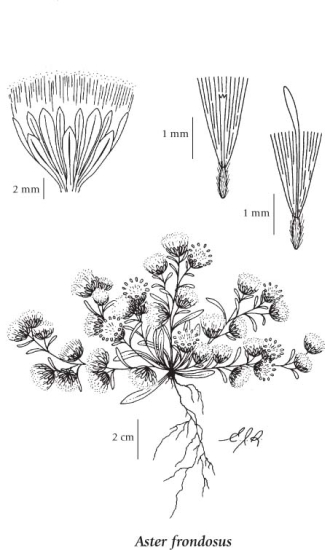Alkali aster is an annual, tap-rooted member of the Asteraceae that is found only in North America, from British Columbia south to Utah, Arizona, New Mexico, California, and Mexico. In BC, it occupies shorelines of lakes and saline ponds in the Okanagan.
Flora North America describes it as occurring in "moist, usually saline soils, summer-receding shores of lakes or ponds, vernally moist, alkaline bottoms, marshes, often in steppes, 10–2200 m". It is a late-summer flowering species that is ecologically tied to natural fluctuations in water levels. Flowering and germination occur following summer drawn down of pond and lake levels. Alkali aster is a seed banking species. It may be confused with the similar
Symphyotrichum ciliatum (rayless alkali aster), but can be distinguished from that species when in flower by the presence of ray petals. Separation after flowering is more difficult. The earliest collection for alkali aster in the UBC Herbarium was by John Eastham (July 1939) from the shoreline of Osoyoos Lake. It has since been collected by Frank Lomer (1993) and George Douglas (1995), also from Osoyoos Lake. Vagrant, ephemeral single plants have been collected by Lomer from sand dredging piles in Surrey (Lomer pers. comm.2007), indicating that as yet undiscovered populations occur upstream. This species was once more abundant in the Osoyoos Lake area prior to lake level management.
Read the COSEWIC status report.
